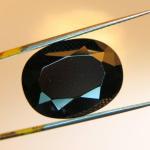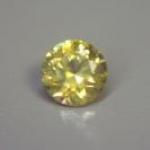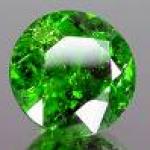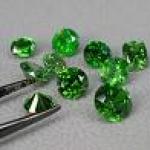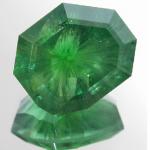
Classes- Alabama
- Alaska
- Arizona
- Arkansas
- California
- Colorado
- Connecticut
- Delaware
- Florida
- Georgia
- Hawaii
- Idaho
- Illinois
- Indiana
- Iowa
- Kansas
- Kentucky
- Louisiana
- Maine
- Maryland
- Massachusetts
- Michigan
- Minnesota
- Mississippi
- Missouri
- Montana
- Nebraska
- Nevada
- New Hampshire
- New Jersey
- New Mexico
- New York
- North Carolina
- North Dakota
- Ohio
- Oklahoma
- Oregon
- Pennsylvania
- Rhode Island
- Tennessee
- Texas
- Utah
- Vermont
- Virginia
- Washington
- West Virginia
- Wisconsin
- Wyoming
| Hardness : 6.5 Specific Gravity : 3.85 Refractive index : 1.85 - 1.8 Doubly Refracting (bi-refraction) : None The garnet variety Andradite is a colorful group named after Brazilian mineralogist José Bonifácio de Andrade e Silva, and is composed of 3 noted subvarieties. Andradite garnets can be found in yellow, red, brown, green, and black. They are highly lusterous, and possess a dispersion greater than that of a diamond. They are often found in matrix with micas, diopside, chlorite, and serpentine. Topazolite is the yellow - green variety, so named because of its resemblance to topaz. Melanite is the dark red / black variety, which is rarely transparent. Historically, it was used a great deal in mourning jewelry, though today it is not used in jewelry. Demantoid is the highly prized green variety of Andradite. It was first found in the Ural Mountains of Russia in 1868. The name Demantoid is Dutch and actually translates to "Diamond like", in reference to its high dispersion rate and luster. Demantoid garnet has been found in areas such as Russia, Italy, Iran, the USA and Namibia. Demantoid gems originating from the Ural Mountains in Russia are the most desired, with their whisps of "horsetail" inclusions which assist in authenticating the stone, and identifying its origins. This is due to factors such as the mineral's depleted status in Russia, as well as Russia's current restrictions on exporting minerals and antiquities. Demantoid was a favorite gemstone used by Russian jeweler Fabergé in his jewel laden artistry. After WWI, Demantoid garnet lost its glitter, and soon faded from the world gem scene. It became a stone coveted by the serious gem collector. The gemstone world was once again aghast in 1996, when a new source of Demantoid garnet was found by a goatherder in Namibia. The material was similar to the Russian material in so many ways, except for one critical component. The chrysolite inclusions, or horsetails, that had been prevalent in the Russian material, were not present. The Namibian material was clean. In the world of gemstones, this is usually a good thing. In the case of Demantoid garnet, it is not. The chrysolite inclusions which are found in the Russian material actually increase the value of the gemstone. A top quality Namibian Demantoid garnet will be less expensive than a lower quality Russian Demantoid. The Russian material is more rare, and is rarely found in sizes over a carat or two. Clean with mild dish soap: use a toothbrush to scrub behind the stone where dust can collect. |
- Birth Stone Gems
- Wedding & Anniversary Gems
- How To Guides
- Fireable Gems
- Nonprofits and Guilds
- Gem Show
- Gem Stone Information
- ·Abalone
- ·Achroite (Tourmaline)
- ·Agate ( Chalcedony)
- ·Alexandrite
- ·Almandine ( Garnet )
- ·Amber
- ·Amethyst ( Quartz)
- ·Ammolite
- ·Andalusite
- ·Andradite Garnet
- ·Apatite
- ·Aquamarine ( Beryl )
- ·Aventurine ( Quartz )
- ·Azurite
- ·Benitoite
- ·Bloodstone ( Chalcedony )
- ·Brown Quartz ( Smokey Quartz )
- ·Calcite
- ·Carnelian ( Chalcedony )
- ·Cassiterite
- ·Celestine
- ·Cerussite
- ·Chalcedony
- ·Chatoyant Quartz
- ·Chrysoberyl
- ·Chrysocolla
- ·Chrysoprase (Chalcedony)
- ·Citrine ( Quartz )
- ·Coral
- ·Danburite
- ·Diamond
- ·Diopside
- ·Dioptase
- ·Dravite ( Tourmaline)
- ·Emerald ( Beryl )
- ·Enstatite
- ·Epidote
- ·Euclase
- ·Fire Agate (Chalcedony)
- ·Fluorite
- ·Gold
- ·Goshenite (Beryl)
- ·Grossular Garnet (Tsavorite Garnet)
- ·Gypsum
- ·Heliodor ( Beryl )
- ·Hematite
- ·Hessonite (Grossular Garnet)
- ·Imperial Topaz
- ·Indicolite ( Tourmaline)
- ·Iolite
- ·Ivory
- ·Jadeite
- ·Jasper (Chalcedony)
- ·Jet
- ·Kornerupine
- ·Kunzite
- ·Kyanite
- ·Labradorite
- ·Lapis Lazuli ( Lazurite)
- ·Lazulite
- ·Malachite
- ·Meerschaum
- ·Microcline
- ·Milky Quartz
- ·Moonstone
- ·Morganite ( Beryl)
- ·Nephrite ( Jade)
- ·Obsidian
- ·Oligoclase
- ·Onyx
- ·Opal
- ·Orthoclase
- ·Padparasha ( Corundum)
- ·Pearl
- ·Peridot
- ·Pink Topaz ( Mercury Myst Vapor )
- ·Plasma ( Chalcedony)
- ·Prase ( Chalcedony )
- ·Prehnite
- ·Pyrite
- ·Pyrope ( Garnet )
- ·Rock Crystal ( Quartz )
- ·Rubellite ( Tourmaline)
- ·Ruby ( Corundum)
- ·Sapphire ( Corundum)
- ·Sardonyx ( Chalcedony)
- ·Scapolite
- ·Schorl (Tourmaline)
- ·Shell
- ·Spessarite (Garnet)
- ·Sphalerite
- ·Spinel
- ·Spodumene (Hiddenite - Triphane)
- ·Tanzanite (Zoisite)
- ·Tektites ( Moldavite )
- ·Tiger Eye
- ·Titanite (Sphene)
- ·Topaz
- ·Turquoise
- ·YAG (Garnet)
- ·Zircon
